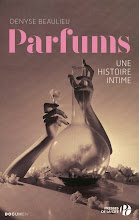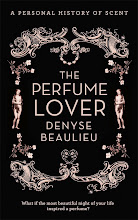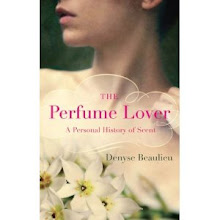Over-ripe fruit flesh dripping with honeyed
vanilla, heated jasmine macerated in hot-cool spices – cardamom, cinnamon,
clove. An erect lily rising from the loam of patchouli and moss… If there is a
ghost that haunts L’Âme perdue (Le Galion) and its author Rodrigo
Flores-Roux, it is that of the fruity spicy chypres descended from Mitsouko
all the way through to the disco-era, stonkingly animalic Rochas Mystère,
by way of Femme…
But
the quintessentially French genre deliberately conjured by Rodrigo Flores-Roux
in his olfactory séance takes on a different emotional tonality here than in
its forerunners. The uncompromising verticality of the chypre form takes a tumble
into that plush bed of Mexican and Madagascan vanilla, disrupted by the carnal exuberance
of the perfumer’s style.
The
working title of the composition that originated L’Âme perdue was “I barely
love you”, as in “hardly”, but also “bare naked”; it went on, as it was
reworked by Rodrigo Flores-Roux, to be renamed “Ladrón de quereres”, “thief of
love”, after an old Mexican song. in French, “l’âme perdue” means “the lost
soul”, and that soul is a sinner’s… In a 2018 interview I did of him, its author
calls L’Âme perdue very sexy perfume with an “idea of decadence, of
perversion, of light flooding into a bedroom when we’d rather it didn’t…”
For all its intricate interplay of historical
references – and few perfumers are as knowledgeable about the history of
perfumery -- the scent’s fierce intellect is primarily erotic in a way
that chypres seldom have been. Or rather, Rodrigo Flores-Roux teases out the genre’s innate eroticism by engorging
its characteristic notes with spiced-up vanilla and honey until he achieves a Baroque
distortion of their proportions.
Born
as a fledgling composition shot down by the brand it was submitted to before it
could take flight, L’Âme perdue is also the lost soul of perfumery, in
that it is the very embodiment of all that contemporary mainstream perfumery
has lost. This is a perfume into which Rodrigo Flores-Roux has poured all his
soul, his fragrant memories, his considerable culture. A perfume, therefore,
laden with personal history and fragrance history; intensely literate and lovingly
nurtured; a marvel of sensual intelligence that may well have become virtually illegible
to noses trained on market-tested blends.
Rodrigo
Flores-Roux speaks of L’Âme perdue
Here
is an excerpt from my conversation with Rodrigo Flores-Roux for the catalogue of
the exhibition “Nez à Nez, parfumeurs contemporains” at the mudac – Museum of
Contemporary Design and Applied Arts, Lausanne, 15.02 – 16.06.2019, published
by Nez Éditions as Sentir, ressentir, Parfumeurs, odeurs et émotions (click here to buy it).
When
I asked him to single out which one of his compositions was dearest to him, Rodrigo
named Le Galion’s L’Âme perdue. This is its origin story:
“About
ten years ago I proposed a perfume to a big American brand, which, while
developing it, I had named ‘I barely love you’ – barely, as in ‘hardly’, but
also barely as in ‘naked’, ‘stripped’. It didn’t pass the tests. But I still had
this accord, I worked on it, I wore it and I got a lot of comments. In 2011, to
celebrate my twenty years as a perfumer, my family organized a soirée for me in
Mexico City. We invited 120 people. I decided to give out a perfume for the
occasion. I took the accord, reworked, softened it and gave it a honeyed
citrusy dimension. I tried to come up with a name and then one evening, when
working late at the office, I played an old Mexican song by Agustín Lara, where
he speaks of a ‘ladrón de quereres’, a thief of love…
And
then, fortunately, fate sometimes brings people into your life who resonate
with you. In 2014 I met Nicolas Chabot, a man of superior emotional and aesthetic
intelligence, who had relaunched Le Galion. This brand played an important role
in my childhood, as my aunt Rosa wore Sortilège
all her life, and my English teacher, Miss Enriqueta, wore Jasmin, which
I fell madly in love with. And then there was Bourrasque – a perfume
that had fascinated me since I was a child. It was a chypre with aspects of Bandit,
Miss Dior and Mitsouko… and Nicolas wanted to relaunch it.
Gradually,
as I worked on it, Bourrasque
began to bear a resemblance to Ladrón de quereres. So I combined the two
formulas. Then Nicolas told me that he was going to release my formula under a
new name, that of a Lanvin perfume from the twenties that he had bought the
rights to: ‘Because, in some way, you are kind of a lost soul.’ So, L’Âme
perdue – the lost soul – is a personal story and the story of friendship: it
is a landmark perfume in my life."
Illustration: "Baroque Nude", by the Mexican painter Germán Gedovius (ca. 1920)











 L'actu
L'actu 

